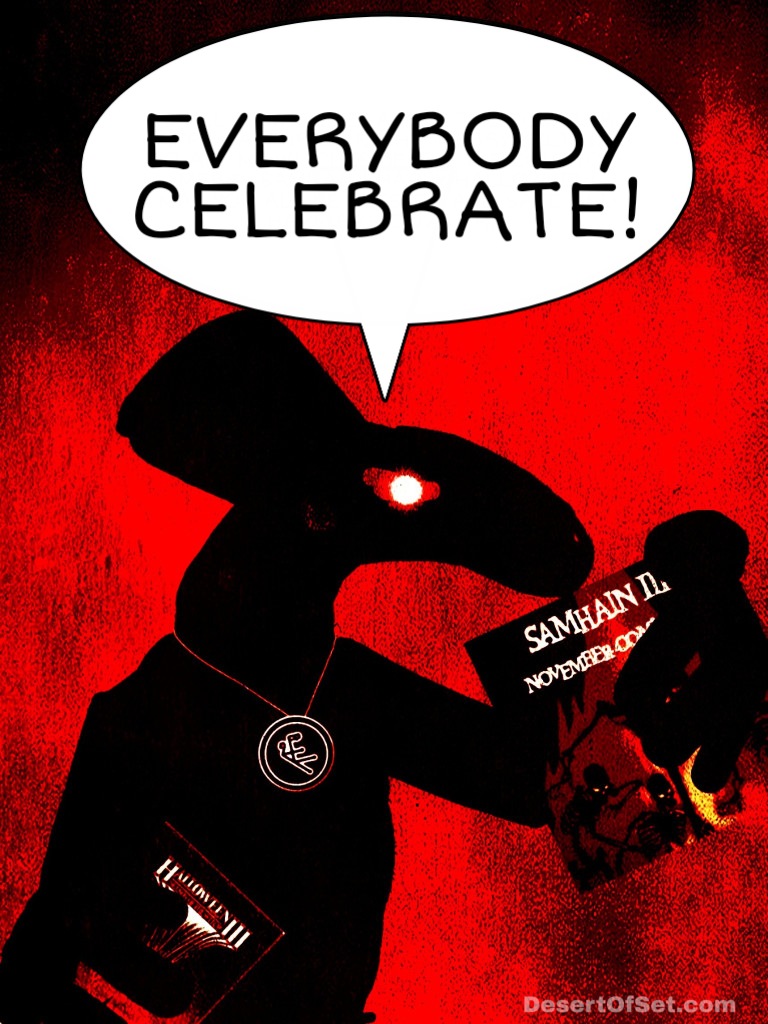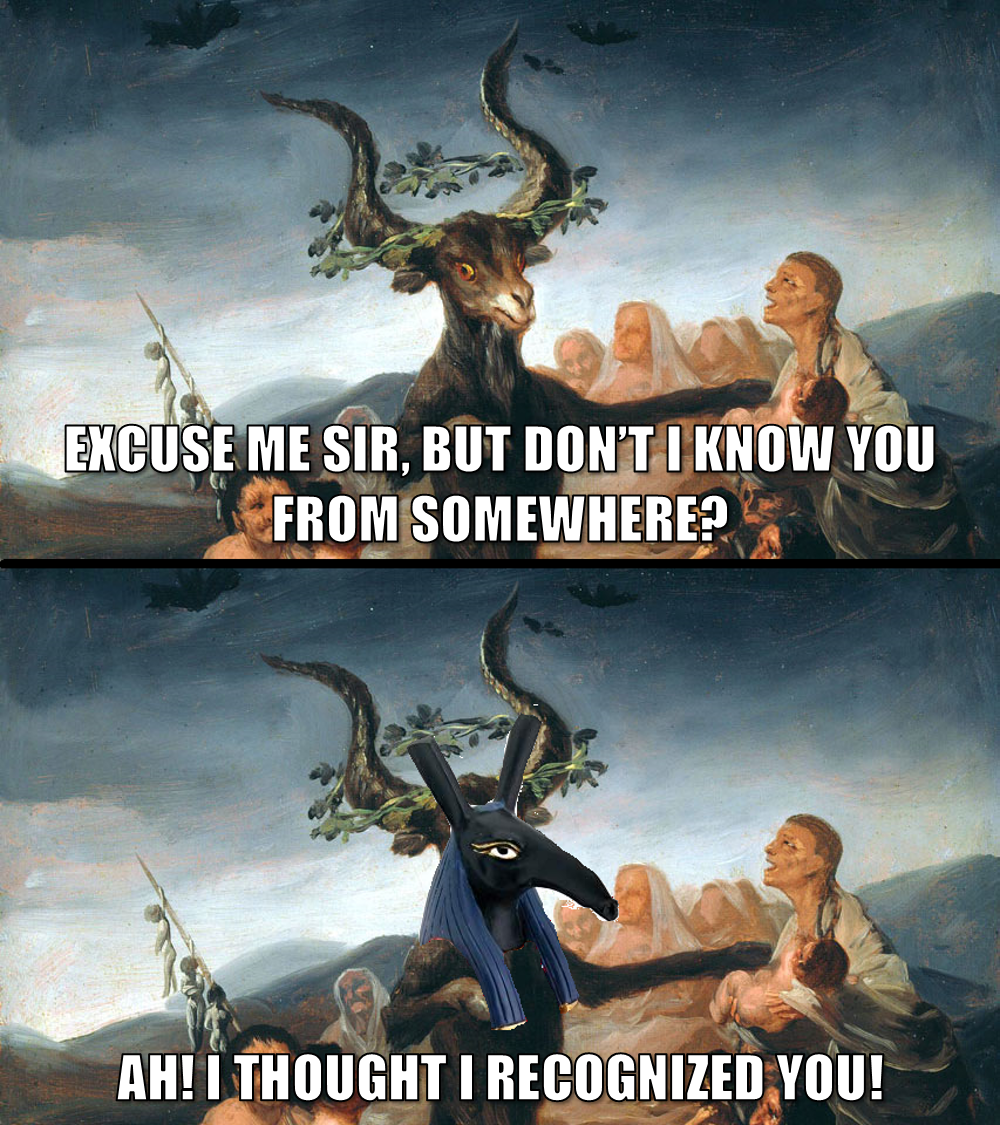The times we consider most sacred in our coven.

Today I figured I’d discuss the major holidays observed by Setians of the LV-426 Tradition. These aren’t necessarily the only holidays we celebrate; some of us also celebrate things like Christmas, Mabon, or even St. Patrick’s Day. But these particular times are the ones we all agree are most important to our shared religious calendar.
The LV-426 Sabbat

The word Sabbat is used differently in many faiths. In LV-426, we use this term in reference to a weekly night of worship that has most often been observed on Friday nights, but which can really be observed on any night of the week. The idea is to meet with Set for a Sabbat every seventh night, in any case, and whenever possible.
Our Sabbat procedure is simple. We use the basic rite that is offered in the very first episode of this series (Setianism: A Brief Introduction). When we get to the part when we speak our wills to Set, we discuss all the high and low points of our week with Him, speaking informally. If more than one person is present for worship, each attendee takes a turn at doing this.
Once everyone has had a chance to say what they wish to say, we throw on some heavy metal and break out the booze, chatting through the night until dawn. Set is asked to remain present if it pleases Him to do so, and He guides the conversations we have during these sessions. There is no other situation in which I am quite so comfortable, happy, or grateful as when I am meeting with Set and my brothers and sister in Him for our Sabbat.

It’s been several years now since our coven has been able to keep the Sabbat together as a group; but the procedure can be followed in a solitary context as well. You don’t even need the booze or the heavy metal; all you really need is to pick a night that works best for you, then try your best to spend some time with Set on that same night every week. How you choose to spend or structure that time with Him is entirely up to you. And if you are unable to follow the same procedure every week for any reason, do not hate on yourself. Set is always with His chosen ones, and He knows what we are all going through. Our Sabbat is not a commandment, but a gift. There is no expectation that we must observe it every week; but it is always there whenever we need it.
Egyptian New Year
The Egyptian New Year festival (or Wep Ronpet, which means “Opening of the Year”) coincides with the heliacal rise of Sirius, the annual flooding of the Nile, and the Dog Days of Summer. It technically falls on a different date each year, and the precise calculation of this date depends on your geographical location.

A heliacal rising occurs when a star that hasn’t been seen in the nighttime sky for a while becomes visible again in the east, just before dawn. Sirius disappears for about 70 days in May, and it reappears toward the end of July and the middle of August. (This is called the “Sothic Cycle.”) The Nile River always floods soon thereafter, just like clockwork. There isn’t much rainfall in Egypt at all, so this annual inundation provided the only means for irrigation in ancient times. And when the Egyptians saw Sirius rising in the east just before dawn in late July, they took it as a sign from the Goddess Isis (the ruler of Sirius) that it was time to start planting all their crops for the year. To this very day, the Egyptian people still celebrate the annual flooding of the Nile as a two-week civil holiday called Wafaa El-Nil, which begins each year on August 15.
August 15 is also a significant date for me personally, as it marks the anniversary of when I first came to Set in 1997. So while everyone who observes this holiday will understandably observe it on different dates due to the Sothic Cycle, I just celebrate it on August 15 each year and call it a day. To be honest, the Dog Days of Summer (which take their name from Sirius, “the Dog Star” in Canis Major) just feel very sacred to me in general.

Wep Ronpet is not just the start of a new year; it is also an echo of the Zep Tepi or “First Time,” when the first God began to stir within the primordial ocean of chaos. One way to mark this occasion is to greet the sun as it rises (on whichever date you prefer to celebrate) beside a body of water (preferably a large one, if possible). As you watch the sunrise, know that you aren’t just watching the start of another day; you are witnessing a “re-run” of the Creation of the universe. Another worthwhile holiday activity would be execrating any negativity you might have collected in your life over the past year, which is something many people who walk with the Egyptian Gods do. (For an example of an execration rite that we use in LV-426, check out Episode #31 of this series.)
Hallowtide
Halloween isn’t “just for kids,” and it wasn’t invented by the candy companies either. It originates from a blend of Celtic folk religion and Roman Catholicism. It is just the first of three holy days—All Hallows’ Eve (October 31), All Saints’ Day (November 1), and All Souls’ Day (November 2)—which are collectively known as Hallowtide.

Even before the Catholic Church reached Great Britain and Ireland, these three dates were already an ancient festival called Samhain (“SOW-wynn”) in Gaelic and Nos Galan Gaeaf (“knows GAIL-uhn GUY-ov”) in Welsh. It marked the end of the harvest season and the start of winter, which was an extremely frightening time for the Celts. Many of them would die of starvation, disease, or freezing temperatures before the following summer. For this reason, the first night of winter weighed heavily upon their minds, and people thought the barriers between this world and the next were temporarily lifted, allowing the dead and other paranormal beings to roam free. This wasn’t so bad when it came to ghosts, who were viewed as beloved ancestors to be welcomed. Malevolent faeries and qliphothic entities were the real concern, and people dressed in frightening animal skins, carved protective charms from turnips, and left out offerings of food to keep such things away. It’s from these ancient traditions that wearing costumes, carving jack o’lanterns, and trick-or-treating are all descended.

Halloween was always my favorite holiday growing up, more important than the winter holidays, and it’s the first thing in which I ever took a religious interest, even before Set. I enjoy handing out candy to trick-or-treaters on October 31st; but once the boils and ghouls have all gone home, I begin my all-night vigil for the dead. I light some candles for our ancestor shrine in the kitchen, and I say some words to our dearly departed. I keep the candles burning all night long, not going to bed until 5:30 in the morning or so. Then I repeat this process the following two nights.
Spooky things do tend to happen during these vigils, like voices or footsteps that come from nowhere (especially around 3:00 am). But nothing scary or sinister ever happens, perhaps due to our ancestors’ protection. Call it “superstition” if you like, but we take this stuff pretty seriously. I think it’s important to keep the true spirit of Halloween alive as much as we can.

Walpurgis
Walpurgisnacht or Walpurgis Night is a spring fertility festival that’s observed each year on April 30. It’s the Teutonic equivalent to May Day or the Celtic Beltaine, but was later renamed after the medieval Christian Saint Walpurga. It represents the cross-quarter point of our solar year between the Spring Equinox and the Summer Solstice, and it’s a time for warding off the last vestiges of winter. It’s most often observed in continental Europe by wearing scary costumes, lighting huge bonfires, and making all kinds of Gods-awful racket to scare away the evil spirits. In fact, you might say Walpurgisnacht is Germany’s version of Halloween; one might even call it “Samhain in the Spring.”

A Walpurgisnacht gathering at the Heidelberg Thingstätten in 2007 (from Wikimedia Commons)
For Setians in LV-426, the lore of witches roaming mountains on this night, throwing bacchanalian rites to a horned God mistaken for “Satan” is suggestive of our own experiences with Set. Since He is a nocturnal God of the wilderness, we’ve always preferred to recite our incantations to Him in lonely woodsy areas after dark (or immediately before dawn). And since the ears of Set’s most holy symbol, the Sha, resemble “horns” (not to mention that some of His other sacred animals include such horned and hoofed critters as antelope and oryx), it is easy enough to conceptualize ourselves as “witches” who invoke a horned God at night. So adopting Walpurgisnacht into our religious calendar has always made sense, at least to us.

With apologies to Francisco Goya…
Perhaps the greatest Walpurgisnacht in LV-426 history so far was in 2005. It was on a Saturday that year, and I was living in Houston. The Tonester drove down to visit me for the whole weekend, and we hit the city together like bricks fired from a machine gun. We roamed every strip club, antique book store, and vintage record shop we could afford at the time, growling the lyrics to all our favorite death metal songs and shouting a random “DUA SET!” at every turn. It was perhaps the only time in my life that I have ever felt completely comfortable wearing my spirituality on my sleeve in public. It was a weekend full of booze, lewd jokes, horror flicks, and about a ton and a half of heavy fuckin’ metal. We really shook the pillars of heaven, by Gods, and when it was over, we both knew Big Red was mighty pleased.

“Turn it up to 11, Hoss!”
Saturday, April 30, 2005: The city of Houston fell under siege to a bizarre sect known only as LV-426. Heads were turned and jaws were dropped as two strapping young lads of Sutekh took to the streets. No slice of pepperoni pizza was safe. No vintage record shop could run. No 1970s folk horror movie could hide. But lo, musical instrument shops had it the worst by far; for Set’s crazed servants did ecstastically hammer on drums, strum on electric guitars, and scream psalms to His Majesty on microphones turned up to 11 in full public view. Never before had such madness been seen or endured by the community, and the dark wizards soon vanished as mysteriously as they had appeared, like a nightmare before the break of day. No evidence remains of the outlandish lunacies that were witnessed on that fateful Walpurgis Night—not even a photograph…

Friday the Thirteenth
When Set slays Osiris in Egyptian mythology, He chops him into 14 pieces, 13 of which are then buried throughout the world (before they are re-assembled and restored to life by Isis), while Set feeds the final piece—Osiris’ phallus—to an elephantfish. (Dennis Wheatley refers to this fish as “the Talisman of Set” in his 1934 novel, The Devil Rides Out.) There were also 13 people at the Last Supper of Christ, which was soon followed by his crucifixion (on a Friday, no less). In both tales, the dying-and-rising God can’t rise from the dead until he is killed first (with Judas Iscariot fulfilling the Setian role in the Christian narrative). The God must be sacrificed before he can rise again and offer new life to the world, and in this context, the number 13 represents initiation: the (often painful) ending of one phase of existence, followed by the glorious emergence of a new and better life.
In LV-426, we don’t view Set and Osiris as “enemies”; we think of the two as being like a gardener and a rosebush, respectively. It’s Set’s job to “prune” Osiris so the latter can produce fresh “blooms,” which keeps the universe alive and healthy. If Set were not there to keep Osiris regenerating himself, there would be no past and no future; there would only be a static present in which nothing new can thrive. So while the experience of being “pruned” by life’s hard knocks certainly isn’t pleasant for anyone, Setians in LV-426 believe it’s important to honor Set for His role in this process. We also think it’s important to take a moment and Hail Osiris as well, and Friday the Thirteenth is our preferred time for doing so.

Watermelon is reported to be one of Set’s favorite foods, and since it’s a plant, it is also sacred to Osiris. So one LV-426 custom for Friday the Thirteenth is to buy a watermelon, recite some prayers over it, chop it up, and share it with Set and Osiris as a sacred meal. As we each eat the watermelon, we also partake of Osiris’ regenerative powers so we can heal and grow back stronger from whatever trials we are currently facing in life. One year, we hosted this dinner at a derelict cemetery, and we respectfully shared our offerings of watermelon with the forgotten ancestors who were buried there.

“Dinner with the Dead” we hosted in honor of Osiris for Friday the 13th, August 2010.
Aside from hockey masks (thanks to Jason Voorhees), black cats are one of the first things people associate with Friday the Thirteenth. Everyone knows the old superstition about how you’ll get “seven years’ bad luck” if a black cat crosses your path. But what most people don’t realize is that cats are actually very lucky creatures to have around, and that black cats are especially lucky. Remember, cats were worshiped in ancient Egypt; they were protected by law from injury and death, and families mourned, mummified, and buried their beloved felines as if they were human beings. Cats were thought to have a special connection to the spirit world, and were especially cherished for driving away evil spirits. The color black was also considered very lucky indeed, given its association with the fertile soil of the Nile Valley. From this perspective, a black cat is twice as lucky as usual, for it not only has all the standard demon-repelling bells and whistles; it also carries the promise of hope, fertility, and regeneration wherever it goes.

My youngest child, Bishop.
The number of days in February and March are such that if Friday the Thirteenth ever falls in the former, it will also fall in the latter (unless we’re in a leap year). Having two consecutive Friday the Thirteenths in the same month like this only happens 3 times every 28 years, and it never happens at any other time of year. For these and other reasons, this occasion is considered highly sacred in LV-426 and is observed as a month-long festival that we call Miew Khem or “the Month of the Black Cat.”




